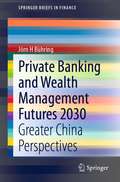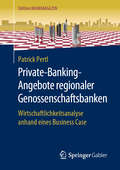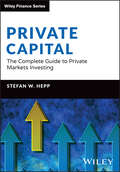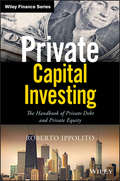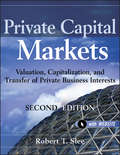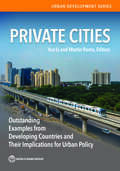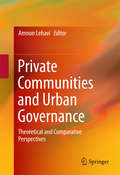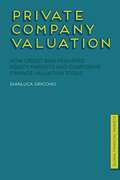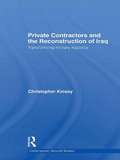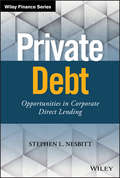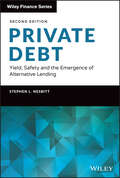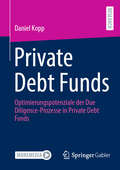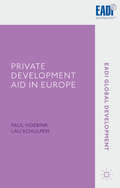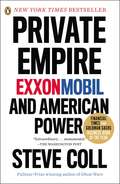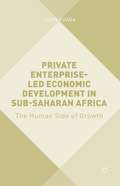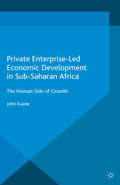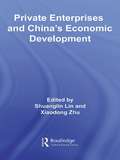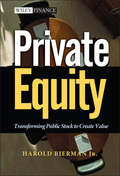- Table View
- List View
Private Banking and Wealth Management Futures 2030: Greater China Perspectives (SpringerBriefs in Finance)
by Jörn H BühringThis book engages the reader around different perspectives between forecasting and foresight in strategic design, drawing insights derived from a futures study that can be applied in form of a design-inspired foresight approach for designers and interdisciplinary innovation teams increasingly called upon to help envisage preferable futures. Demonstrating this process in applied research, the book describes a 2016 Financial Services industry futures study to the year 2030. An industry increasingly at risk in dealing with uncertainty, the Financial Services sector, is a core pillar of economic activity in most markets, such as greater China, and inherent within are major drivers of change linked to consumer behaviors, new technology and disruptive business models. While the financial services industry exemplifies an ideal case for design-inspired foresight, the aims of this book are primarily to establish the peculiarities between traditional forecasting applications and a design-inspired foresight visioning approach as strategic design activities for selecting preferable futures. Underlining the contribution of this book is the value of design futures thinking as a creative and divergent thought process, which has the potential to respond to the much broader organizational reforms needed to sustain in today’s rapidly evolving business environment.
Private-Banking-Angebote regionaler Genossenschaftsbanken: Wirtschaftlichkeitsanalyse anhand eines Business Case (Edition Bankmagazin)
by Patrick PertlDieses Buch befasst sich mit dem Private Banking in Regionalbanken und hier insbesondere in Genossenschaftsbanken. Es stellt die aktuellen Entwicklungen und Rahmenparameter im Private Banking zusammenfassend dar. Zudem zeigt es insbesondere für kleinere Genossenschaftsbanken Konzepte für den Auf-/Ausbau eines Private-Banking-Segments auf. Die grundsätzliche Idee für dieses Buch entwickelte sich im Rahmen meiner Masterarbeit im Jahr 2015. Das Buch selbst entstand inhaltlich danach und berücksichtigt Entwicklungen bis Anfang des Jahres 2019. In dieser Zeit haben sich für Banken insbesondere durch die anhaltende Niedrigzinspolitik der Europäischen Zentralbank einige Herausforderungen ergeben, die insbesondere zu sinkenden Einnahmen aus dem Konditionsbeitrag geführt haben. Neben dem Firmenkundengeschäft stellt das Private Banking einen der Bereiche in Regionalbanken dar, der aktuell steigende Einnahmen zu verzeichnen hat. Das wiederum führt dazu, dass sich immer mehr auch kleinere Banken verstärkt mit diesem Themenfeld beschäftigen.
Private Banking in Europe: Serious Wealth (Routledge International Studies in Money and Banking)
by Lynn BickerPrivate banking is one of the highest growth and most profitable financial businesses in Europe. A large proportion of the market remains untapped and the 1990s are likely to bring significant expansion in developing countries. Private Banking in Europe provides new insights into the private banking industry, its growth and future, and emerging opportunities for private bankers and their clients. It debates the importance of global and local service; the potential dichotomy between the wealthy and the successful, and considers the private banking industry. A comparison of key players and their chosen markets and strategies is complemented by an exploration of the growth of intermediaries and unexpected competitiors. The work also includes a study of non-European influences. The book offers a valuable insight into private banking, through the eyes of the bankers themselves. The final chapter is devoted to private bankers' own view of their industry, their competition and future directions.
Private Capital: The Complete Guide to Private Markets Investing (The Wiley Finance Series)
by Stefan W. HeppIn Private Capital: The Complete Guide to Private Markets Investing, renowned private markets investor and expert Dr. Stefan W. Hepp delivers an insightful and comprehensive exploration of the history, nature, and influence of private market investing. The author offers a robust examination of the key practical and conceptual issues faced by investors as they move forward into the future. In the book, you'll find fulsome discussions of the rise of private market investment following the conclusion of World War II, as well as why the limited partnership became the dominant investment vehicle for private equity. You'll also discover the importance of the convergence of technology, government, academia, and venture capital that came to define what we now know as Silicon Valley. The book includes: Explanations of the emergence of buyout firms, as well as why and how buyouts differ from other forms of mergers and acquisitions Examinations of the explosive growth of private equity and other private asset classes since the turn of the millennium Discussions of the issues set to dominate the future of private markets, including ESG investing, value creation, unicorns, special purpose acquisition companies (SPACs), and more A must-read book for regulators, investors, asset managers, entrepreneurs, founders, and other businesspeople, Private Capital will earn a place on the bookshelves of anyone with a stake or interest in private equity and other private asset classes.
Private Capital and Public Policy: Standard & Poor's Sovereign Credit Ratings
by Christopher M. Bruner Rawi AbdelalDescribes Standard & Poor's sovereign credit ratings business. Provides background on the history of credit ratings agencies, the meaning of credit ratings, the expansion of the sovereign ratings business over recent decades, and the market for credit ratings. Also, discusses current debates in the United States and elsewhere relating to the use of credit ratings in financial and prudential regulation.
Private Capital Investing: The Handbook of Private Debt and Private Equity (Wiley Finance)
by Roberto IppolitoA step-by-step, comprehensive approach to private equity and private debt Private Capital Investing: The Handbook of Private Debt and Private Equity is a practical manual on investing in the two of the most common alternative asset classes (private equity and private debt) and provides a unique insight on how principal investors analyze investment opportunities. Unlike other textbooks available in the market, Private Capital Investing covers the various phases that principal investors follow when analyzing a private investment opportunity. The book combines academic rigor with the practical approach used by leading institutional investors. Chapters are filled with practical examples, Excel workbooks (downloadable from the book website), examples of legal clauses and contracts, and Q&A. Cases are referred at the end of every chapter to test the learning of the reader. Instructors will find referrals to both third-party cases or cases written by the author. • Covers analytical tools • Includes the most common methods used to structure a debt facility and a private equity transaction • Looks at the main legal aspects of a transaction • Walks readers through the different phases of a transaction from origination to closing Bridging the gap between academic study and practical application, Private Capital Investing enables the reader to be able to start working in private equity or private debt without the need for any further training. It is intended for undergraduates and MBA students, practitioners in the investment banking, consulting and private equity business with prior academic background in corporate finance and accounting.
Private Capital Markets
by Robert T. SleePraise for Private Capital MarketsValuation, Capitalization, and Transfer of Private Business Interests"In the years since publication of the first edition of Private Capital Markets, the concepts and ideas that it presents have been widely accepted by progressive members of the business valuation community. Now with the Second Edition, author Rob Slee has included empirical data on capital markets for midsized businesses. This book remains a must for everyone involved in appraising, buying, selling, or financing privately owned businesses."-Raymond C. Miles, founder, The Institute of Business Appraisers"The Graziadio School of Business has used the Private Capital Markets book for several years with great success. This course, along with the Pepperdine Private Capital Markets Survey project, has helped our students better prepare for careers in middle market companies."-Linda Livingstone, Dean of the Graziadio School of Business and Management,Pepperdine University"Our international association of independent M&A professionals recommends this text as the most comprehensive foundation for understanding the private capital marketplace. This book is essential reading for middle market M&A advisors, investors, and other decision-makers in the private capital markets." -Mike Nall, founder, Alliance of M&A AdvisorsA practical road map for making sound investment and financing decisions based on real experiences and market needsNow fully revised and in a second edition, Private Capital Markets provides lawyers, accountants, bankers, estate planners, intermediaries, and other professionals with a workable framework for making sound investment and financing decisions based on their own needs and experiences.This landmark resource covers: Private business valuation Middle market capital sources The business ownership transfer spectrum And much morePrivate Capital Markets, Second Edition surveys the private capital markets and presents the proven guidance you need to navigate through these uncharted waters.
Private Cities: Outstanding Examples from Developing Countries and Their Implications for Urban Policy (Urban Development)
by Yue Li and Martin RamaInstitutional constraints and weak capacity often hamper the ability of local governments in developing countries to steer urbanization. As a result, there are not enough cities to accommodate an unabated rural-urban migration and many of those that exist are messy, sprawling, and disconnected. The flipside is the emergence of entire cities--more than gated communities or industrial parks--led in whole or in part by private actors. To date, little systematic research has been conducted on the conditions that are necessary for such unusual entities to emerge, on the roles played by private actors, or on the consequences for efficiency and equity. 'Private Cities: Outstanding Examples from Developing Countries and Their Implications for Urban Policy' aims to fill this gap. Using an analytical framework that draws on urban economics and political science, it includes inventories of private cities in the Arab Republic of Egypt, India, Indonesia, and Pakistan and provides structured reviews of 14 outstanding examples across all developing regions. Nongovernment actors turn out to be diverse--they include not only major companies and large developers but also business associations, civil society organizations, and even foreign countries. The way local governments interact with these nongovernment actors varies as well, from deliberate neglect to joint ventures. Private actors take on some--but not all--local government functions, while at times embracing unconventional roles. And while private cities tend to be economically successful, they can lead to environmental degradation, social segregation, and even institutional secession. Increasing the capacity of local governments in developing countries will take time.Along the way, inefficient spatial development patterns may be locked in. There is a case for selectively tapping into the comparative advantage of significant private actors while actively using policy tools to avoid the potential shortcomings. In the spirit of a publicprivate partnership for urbanization, land value capture would be at the center of this approach.
Private Communities and Urban Governance
by Amnon LehaviThis book offers an interdisciplinary and comparative study of the complex interplay between private versus public forms of organization and governance in urban residential developments. Bringing together top experts from numerous disciplines, including law, economics, geography, political science, sociology, and planning, this book identifies the current trends in constructing the physical, economic, and social infrastructure of residential communities across the world. It challenges much of the conventional wisdom about the division of labor between market-driven private action and public policy in regulating residential developments and the urban space, and offers a new research agenda for dealing with the future of cities in the twenty-first century. It represents a unique ongoing academic dialogue between the members of an exceptional group of scholars, underscoring the essentially of an interdisciplinary and comparative approach to the study of private communities and urban governance. As such, the book will appeal to a broad audience consisting of policy-makers, practitioners, scholars, and students across the world, especially in developing countries and transitional and emerging economies.
The Private Company Council
by Karthik Ramanna Luis M. ViceiraFinancial Accounting Foundation chairman Jack Brennan is under pressure from private-company interests to set up a new body-the Private Company Council-to determine separate GAAP for private companies. PCC advocates-including the US Chamber of Commerce-argue that traditional US GAAP has too many disclosure and fair-value requirements that impose very high compliance costs on private companies. But there are influential players-including the Big Four auditors-who oppose creating the PCC. They argue that the compliance costs of traditional GAAP are the price of high-quality accounting standards. Balancing these powerful interests, Brennan must make a decision on the PCC; at stake is US GAAP's ability to facilitate capital allocation decisions in the economy.
The Private Company Council
by Luis M. Viceira Karthik RamannaFinancial Accounting Foundation chairman Jack Brennan is under pressure from private-company interests to set up a new body-the Private Company Council-to determine separate GAAP for private companies. PCC advocates-including the US Chamber of Commerce-argue that traditional US GAAP has too many disclosure and fair-value requirements that impose very high compliance costs on private companies. But there are influential players-including the Big Four auditors-who oppose creating the PCC. They argue that the compliance costs of traditional GAAP are the price of high-quality accounting standards. Balancing these powerful interests, Brennan must make a decision on the PCC; at stake is US GAAP's ability to facilitate capital allocation decisions in the economy.
Private Company Valuation
by Gianluca OricchioThe recent crisis in financial markets has seen a gradual erosion of risk-free asset classes. In equity markets the credit risk has reached a critical level in valuation. Here a new cost of equity method for private companies is presented based on the pricing of junior subordinated notes. Global business cases are illustrated to support this.
Private Contractors and the Reconstruction of Iraq: Transforming military logistics
by Christopher KinseyThis book explains how and why the US and UK governments became so dependent upon military contractors during the war in Iraq. <P><P>It also examines the ramifications this new dependency will have on future military operations, as the conflict in Iraq has shown that private contractors are now indispensable to the attainment of both the military and political objectives of war.
Private Debt: Opportunities in Corporate Direct Lending (Wiley Finance)
by Stephen L. NesbittPrivate Debt: Opportunities in Corporate Direct Lending provides investors with a single, comprehensive resource for understanding this asset class amidst an environment of tremendous growth. Traditionally a niche asset class pre-crisis, corporate direct lending has become an increasingly important allocation for institutional investors—assets managed by Business Development Company structures, which represent 25% of the asset class, have experienced over 600% growth since 2008 to become a $91 billion market. Middle market direct lending has traditionally been relegated to commercial banks, but onerous Dodd-Frank regulation has opened the opportunity for private asset managers to replace banks as corporate lenders; as direct loans have thus far escaped the low rates that decimate yield, this asset class has become an increasingly attractive option for institutional and retail investors. This book dissects direct loans as a class, providing the critical background information needed in order to work effectively with these assets.
Private Debt: Yield, Safety and the Emergence of Alternative Lending (Wiley Finance)
by Stephen L. NesbittAn essential resource for creating outsized returns in the private debt markets In Private Debt II: Finding Yield in a Zero Interest World, renowned investment advisor and industry leader Stephen Nesbitt delivers yet another essential resource for investors seeking to acquire private debt options in the investment market, including corporate direct lending, asset-backed lending, mezzanine lending, royalties, venture debt, structured credit (CLOs), specialty finance, and structured equity. Building on the success and popularity of Private Debt: Opportunities in Corporate Direct Lending, this latest edition of the author’s flagship text helps readers understand this complex and rapidly growing asset class. The book also offers: Explorations of the opportunities, relevant risks, and historical yield provided by private debt Discussions of a variety of loan investment vehicles, including the Business Development Company structure Strategies for structuring a direct loan portfolio and how to fit it into your overall investment strategyA can’t-miss resource for serious investors looking for opportunities to earn higher yields than those offered by traditional index funds while still retaining reasonable safety of principle and liquidity, Private Debt II will undoubtedly become the go-to guide for anyone looking for tried and tested debt investment strategies.
Private Debt Funds: Optimierungspotenziale der Due Diligence-Prozesse in Private Debt Fonds
by Daniel KoppDiese Studie gibt einen umfassenden Überblick in die Arbeit von Private Debt Fonds, die historischen Marktentwicklungen sowie die regulatorischen Gegebenheiten innerhalb welcher sich Private Debt Fonds und deren Investoren bewegen. In diesem Zusammenhang ergibt sich die Fragestellung, welche Stärken und Schwächen die verwendeten Due Diligence-Verfahren der Private Debt Fonds innehaben und welche Verbesserungsoptionen für bestimmte Arten von Private Debt Fonds zur Erreichung ihrer strategischen Zielsetzungen empfehlenswert sind. Auf Grundlage einer umfassenden Studie werden hier die Haupteinflussfaktoren der Due-Diligence-Qualität in Private Debt Fonds vorgestellt und analysiert.
Private Development Aid in Europe: Foreign Aid between the Public and the Private Domain (EADI Global Development Series)
by Paul HoebinkThe authors present an overview of private development aid in Belgium, Denmark, Finland, France, Ireland, Italy, the Netherlands, Spain, and the EU as a whole. They illustrate how private aid organisations receive support as well as the relations they have with their respective governments.
Private Development Aid in Europe
by Paul Hoebink Lau SchulpenThe authors present anoverview of private development aid in Belgium, Denmark, Finland, France, Ireland, Italy, the Netherlands, Spain, and the EU as a whole. They illustrate how private aid organisations receive support as well as the relations they have with their respective governments. "
Private Empire
by Steve CollAn "extraordinary" and "monumental" exposé of Big Oil from two-time Pulitzer Prize winner Steve Coll (The Washington Post)In this, the first hard-hitting examination of ExxonMobil--the largest and most powerful private corporation in the United States--Steve Coll reveals the true extent of its power. Private Empire pulls back the curtain, tracking the corporation's recent history and its central role on the world stage, beginning with the Exxon Valdez accident in 1989 and leading to the Deepwater Horizon oil spill in the Gulf of Mexico in 2010. The action spans the globe--featuring kidnapping cases, civil wars, and high-stakes struggles at the Kremlin--and the narrative is driven by larger-than-life characters, including corporate legend Lee "Iron Ass" Raymond, ExxonMobil's chief executive until 2005. A penetrating, news-breaking study, Private Empire is a defining portrait of Big Oil in American politics and foreign policy.
Private Empire
by Steve CollAn "extraordinary" and "monumental" exposé of Big Oil from two-time Pulitzer Prize winner Steve Coll (The Washington Post) In this, the first hard-hitting examination of ExxonMobil--the largest and most powerful private corporation in the United States--Steve Coll reveals the true extent of its power. Private Empire pulls back the curtain, tracking the corporation's recent history and its central role on the world stage, beginning with the Exxon Valdez accident in 1989 and leading to the Deepwater Horizon oil spill in the Gulf of Mexico in 2010. The action spans the globe--featuring kidnapping cases, civil wars, and high-stakes struggles at the Kremlin--and the narrative is driven by larger-than-life characters, including corporate legend Lee "Iron Ass" Raymond, ExxonMobil's chief executive until 2005. A penetrating, news-breaking study, Private Empire is a defining portrait of Big Oil in American politics and foreign policy.
Private Empire
by Steve CollAn "extraordinary" and "monumental" exposé of Big Oil from two-time Pulitzer Prize winner Steve Coll (The Washington Post) In this, the first hard-hitting examination of ExxonMobil--the largest and most powerful private corporation in the United States--Steve Coll reveals the true extent of its power. Private Empire pulls back the curtain, tracking the corporation's recent history and its central role on the world stage, beginning with the Exxon Valdez accident in 1989 and leading to the Deepwater Horizon oil spill in the Gulf of Mexico in 2010. The action spans the globe--featuring kidnapping cases, civil wars, and high-stakes struggles at the Kremlin--and the narrative is driven by larger-than-life characters, including corporate legend Lee "Iron Ass" Raymond, ExxonMobil's chief executive until 2005. A penetrating, news-breaking study, Private Empire is a defining portrait of Big Oil in American politics and foreign policy.
Private Enterprise-Led Economic Development in Sub-Saharan Africa: The Human Side of Growth
by John KuadaPrivate Enterprise-Led Development in Sub-Saharan Africa provides a novel theoretical and conceptual model to guide research into Africa's economic development. It endorses the view that private enterprise-led growth will help reduce poverty since it strengthens individuals' capacity to care for themselves and their families.
Private Enterprise-Led Economic Development in Sub-Saharan Africa: The Human Side of Growth
by John KuadaPrivate Enterprise-Led Development in Sub-Saharan Africa provides a novel theoretical and conceptual model to guide research into Africa's economic development. It endorses the view that private enterprise-led growth will help reduce poverty since it strengthens individuals' capacity to care for themselves and their families.
Private Enterprises and China's Economic Development (Routledge Studies in the Growth Economies of Asia)
by Shuanglin Lin Xiaodong ZhuPrivate enterprises have contributed significantly to China's recent economic growth and will play a key role in achieving China's goal of building a comprehensively well-society. But how can private enterprises help China mitigate its macroeconomic problems such as unemployment, income inequality, financial disintermediation, and an unhealthy economic cycle? And what are the main obstacles to private enterprise development? Private Enterprises and China’s Economic Development answers these questions by identifying the range of cultural, political and financial challenges confronting China's private enterprises, and assessing their performance and potential. Contributors also analyse the experiences and lessons of other countries, and propose strategies and policies to help China promote private enterprise development. Using the most up to date research on private enterprises, including detailed econometric analysis and national representative data, authors including economists, policy-makers and academics from the USA, China, Singapore and Canada comprehensively address the most important aspects of China’s private enterprise development. As such this book will appeal to students, scholars and policy-makers alike with an interested in the Chinese economy, economic growth, comparative economics and transitional economics.
Private Equity
by Harold Bierman Jr.Praise for Private Equity"Harold Bierman has blended an excellent mix of important principles with real case study examples for a better understanding on a rather sophisticated finance subject."-Edward M. Dudley, Vice President & General Auditor, ABB Americas"The role of private equity firms in financing buyouts as well as providing growth capital has expanded significantly in the past decade. In a clear, concise way, Harold Bierman provides a timely and astute analysis of the virtues of private equity as well as creative quantitative methodologies that are applicable to real-life transactions. This book should become essential reading for investors, intermediaries, financial advisors and the management of private, almost private, or soon-to-be private firms."-James A. Rowan Jr., Managing Director, Investment BankingLegg Mason Wood Walker, Inc."As the private equity asset class has grown to over $300 billion in the last three years, Bierman analyzes the fundamentals behind the investment decisions of this increasingly important sector. Once completing the book, you will understand the fundamental analytical framework underlying private equity investment."-Peter Nolan, Partner, Leonard Green and Partners"In looking at the private equity arena, Professor Bierman has brought together a diverse group of metrics and valuation formulas into a single text. The book provides a valuable combination of academic theory and real-life case studies. It provides many insights."-Peter H. Vogel, Vice President, MeadWestvaco Corporation
